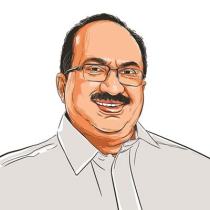About false promises
RBI data has confirmed that demonetisation failed in its stated goals.

Newly released data from the RBI shows that 99.3 per cent of high-value notes in circulation — worth about Rs.15.3 lakh crore — came back to the banks. (Express Photo by Pradip Das)
India replaced its currency to wipe out illegal money stashes. The Reserve Bank of India (RBI) in its annual report effectively says it didn’t work.
When Prime Minister Narendra Modi announced the replacement of 80 per cent of India’s cash in November 2016, he sparked a currency crisis that led to huge job losses and stalled growth as it hit India’s vast informal sector. For months, people lined up at banks and ATMs, sometimes for more than eight hours, to withdraw limited amounts of cash to pay bills or buy daily groceries. Their troubles were a sacrifice for the nation, Modi said at the time. Old notes would be handed back to the banks, and the vast reserves of untaxed “black money” being used for dodgy deals among fat-cat businessmen, dirty politicians and Pakistani terrorists would be invalidated in one fell swoop.
Now, newly released data from the RBI shows that 99.3 per cent of high-value notes in circulation — worth about Rs.15.3 lakh crore — came back to the banks. That means those illicit hoards the government was hoping to flush out of the system were not in the form of cash and are still out there. And the long lines for cash, not to mention the losses in jobs and growth? They were not needed at all. The RBI has, in effect, said the prime minister’s premises and claims were dubious.
India’s economy runs mostly on cash, so Modi’s demonetisation thoroughly shook the country. The New Delhi-based Center for Monitoring the Indian Economy estimated that the shock move caused the loss of at least 15 lakh jobs. In the weeks and months after Modi’s announcement, small-business owners said their customers stopped coming because they had no cash. Marriages were delayed because cash stacked up to pay for venues and caterers was now worthless. Some found clever ways to avoid the long lines, such as bribing bank managers or paying people to stand in their place. But many who stood in lines said they supported Modi and his efforts to clean up India’s economy at the time.
The new data suggests that the entire policy was not thought out properly. All reports on black money categorically states that the undeclared incomes were mostly invested in property and assets in India and abroad and in gold and jewellery. The cash with people was cash in stock and deployed for everyday business and living.
The RBI has now reported receiving back 99.3 per cent of the Rs 500 and Rs 1,000 denomination notes, which ceased to be legal tender, amounting to Rs 15.3 lakh crore. This means around Rs 10,000 crore of the Rs 500 and Rs 1,000 denomination notes are not accounted. Quite minuscule considering the initial projection of Rs 3-5 lakh crore claimed by Modi. The RBI spent Rs 11,386 crore in printing the new Rs 500 and Rs 2,000 denomination notes. That is not considering the cost incurred by banks in recalibrating the ATM machines for the new notes or the cost incurred in collection, movement and storage of notes across the country.
Modi came to power on “promises” and “propaganda”. Four years since, where does India stand?
Rupee has become the worst performing of all Asian currencies, plunging to a historic low of 70.47 against the US dollar. Petrol and diesel prices are at a historic high, despite international crude prices at less than 50 per cent of what it was during the UPA government. Meanwhile, India is facing a balance of payment crisis and the current account deficit has reached 2.8 per cent of GDP.
A poorly and hastily implemented GST has wreaked havoc on the SME sector and the common man. Even the much harped GDP growth is, in fact, a dip from the UPA days, once the new series are back-tracked. Government records indicate a slowdown from a high of 10.78 per cent to 7.3 per cent in recent months, recovering from the 6 per cent levels post demonetisation.
Demonetisation has not helped in controlling terrorism in Kashmir or eliminating the Naxalites. Over a hundred people died in the chaos triggered by demonetisation and lakhs lost their jobs. Small and medium enterprises and farmers are yet to fully recover from the unprepared withdrawal of cash. The so-called jump in cashless payment came down once currency infusion became normal. Modi’s pre-election slogan of corruption-free India has become a farce with Vijay Mallya, Mehul Choksi, Nirav Modi, Lalit Modi etc. being allowed to flee India.
Modi and the BJP continue to shift the goalpost on demonetisation, with no visible benefits.
The writer is a Congress MP and former Union minister.






































No hay comentarios:
Publicar un comentario